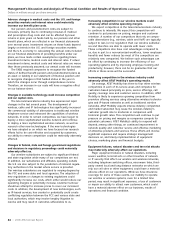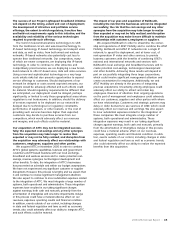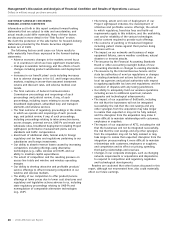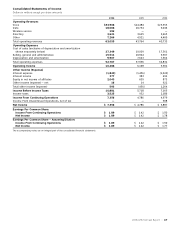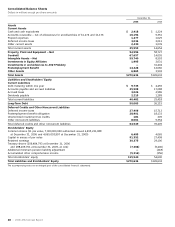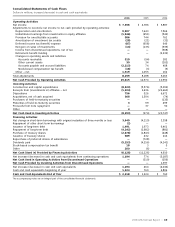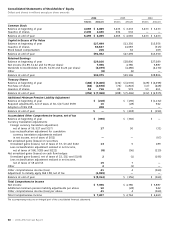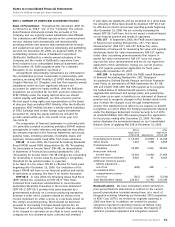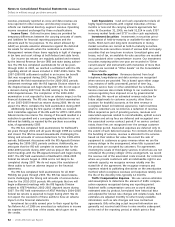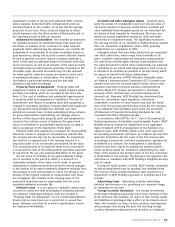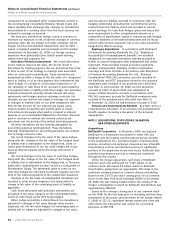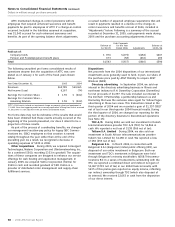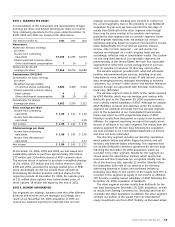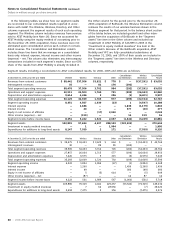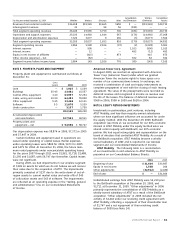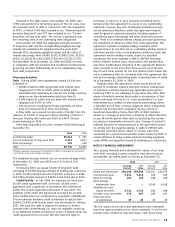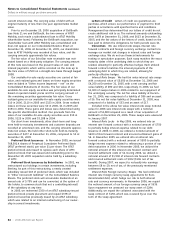AT&T Wireless 2006 Annual Report Download - page 56
Download and view the complete annual report
Please find page 56 of the 2006 AT&T Wireless annual report below. You can navigate through the pages in the report by either clicking on the pages listed below, or by using the keyword search tool below to find specific information within the annual report.
54 : :
2006 AT&T Annual Report
Notes to Consolidated Financial Statements (continued)
Dollars in millions except per share amounts
component of accumulated other comprehensive income in
the accompanying Consolidated Balance Sheets. Gains and
losses resulting from exchange-rate changes on transactions
denominated in a currency other than the local currency are
included in earnings as incurred.
We have also entered into foreign currency contracts to
minimize our exposure to risk of adverse changes in currency
exchange rates. We are subject to foreign exchange risk for
foreign currency-denominated transactions, such as debt
issued, recognized payables and receivables and forecasted
transactions. At December 31, 2006, our foreign currency
exposures were principally Euros, British pound sterling,
Danish krone and Japanese Yen.
Derivative Financial Instruments We record derivatives
on the balance sheet at fair value. We do not invest in
derivatives for trading purposes. We use derivatives from time
to time as part of our strategy to manage risks associated
with our contractual commitments. These derivatives are
designated as either a hedge of the fair value of a recognized
asset or liability or of an unrecognized firm commitment (fair
value hedge), or a hedge of a forecasted transaction or of
the variability of cash flows to be received or paid related to
a recognized asset or liability (cash flow hedge). Our derivative
financial instruments primarily include interest rate swap
agreements and foreign currency exchange contracts. For
example, we use interest rate swaps to manage our exposure
to changes in interest rates on our debt obligations (see
Note 8). We account for our interest rate swaps using
mark-to-market accounting and include gains or losses
from interest rate swaps when paid or received in interest
expense on our Consolidated Statements of Income. Amounts
paid or received on interest rate forward contracts are
amortized over the period of the related interest payments.
All other derivatives are not formally designated for
accounting purposes (undesignated). These derivatives,
although undesignated for accounting purposes, are entered
into to hedge economic risks.
We record changes in the fair value of fair value hedges,
along with the changes in the fair value of the hedged asset
or liability that is attributable to the hedged risk. Gains or
losses upon termination of our fair value hedges are recog-
nized as interest expense when the hedge instrument is
settled.
We record changes in the fair value of cash flow hedges,
along with the changes in the fair value of the hedged asset
or liability that is attributable to the hedged risk, in “Accumu-
lated other comprehensive income,” which is a component of
Stockholders’ Equity. The settlement gains or costs on our
cash flow hedges are amortized as interest expense over the
term of the interest payments of the related debt issuances.
Changes in the fair value of undesignated derivatives are
recorded in other income (expense), net, along with the
change in fair value of the underlying asset or liability, as
applicable.
Cash flows associated with derivative instruments are
presented in the same category on the Consolidated State-
ments of Cash Flows as the item being hedged.
When hedge accounting is discontinued, the derivative is
adjusted for changes in fair value through other income
(expense), net. For fair value hedges, the underlying asset or
liability will no longer be adjusted for changes in fair value,
and any asset or liability recorded in connection with the
hedging relationship (including firm commitments) will be
removed from the balance sheet and recorded in current-
period earnings. For cash flow hedges, gains and losses that
were accumulated in other comprehensive income as a
component of stockholders’ equity in connection with hedged
assets or liabilities or forecasted transactions will be recog-
nized in other income (expense), net, in the same period the
hedged item affects earnings.
Employee Separations In accordance with Statement
of Financial Accounting Standards No. 112, “Employers’
Accounting for Postemployment Benefits,” we establish
obligations for expected termination benefits provided to
former or inactive employees after employment but before
retirement. These benefits include severance payments,
workers’ compensation, disability, medical continuation
coverage and other benefits. In accordance with Statement
of Financial Accounting Standards No. 141, “Business
Combinations” (FAS 141), severance accruals recorded for
the BellSouth and ATTC acquisition related to the acquired
employees were included in the purchase price allocation
(see Note 2). At December 31, 2006, we had severance
accruals of $263, of which $240 was established as
merger-related severance accruals. In accordance with
FAS 141, severance accruals for BellSouth employees were
included in the purchase price allocation (see Note 2).
At December 31, 2005, we had severance accruals of $410.
Pension and Postretirement Benefits See Note 10 for a
comprehensive discussion of our pension and postretirement
benefit expense, including a discussion of the actuarial
assumptions.
NOTE 2. ACQUISITIONS, DISPOSITIONS, VALUATION
AND OTHER ADJUSTMENTS
Acquisitions
BellSouth Corporation In December 2006, we acquired
BellSouth in a transaction accounted for under FAS 141.
BellSouth was the leading communications service provider
in the southeastern U.S., providing wireline communications
services, including local exchange, network access, intraLATA
long-distance services and Internet services to substantial
portions of the population across nine states. BellSouth also
provided long-distance services to enterprise customers
throughout the country.
Under the merger agreement, each share of BellSouth
common stock was exchanged for 1.325 shares of our
common stock. We issued 2.4 billion shares to BellSouth
shareholders, giving them an approximate 39% stake in the
combined company, based on common shares outstanding.
Based on the $35.75 per share closing price of our common
stock on the New York Stock Exchange (NYSE) on December
29, 2006, the last trading session before the closing of the
merger, consideration received by BellSouth shareholders was
approximately $86,900.
Based on the average closing price of our common stock
on the NYSE for the two days prior to, including, and two days
subsequent to the public announcement of the merger (March
5, 2006) of $27.32, capitalized merger-transaction costs and
other items, the transaction was valued, for accounting
purposes, at $66,798.


